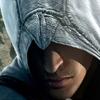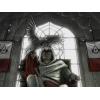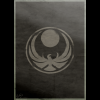Some history (just not yet)
I was browsing in a museum gift shop today and came across this book: "The Artist, The Philosopher, and The Warrior: The intersecting lives of Da Vinci, Machiavelli and Borgia and the world they shaped", by Paul Strathern, published last year. So of course I had to have it.
I'll quote from the jacket flap:
The Renaissance was a child of many fathers - none more important than the three iconic figures whose intersecting lives provide the basis for this astonishing work of narrative history: Leonardo da Vinci, Niccolo Machiavelli, and Cesare Borgia. They could not have been more different, and they would meet only for a short time in 1502, but the events that transpired when they did would significantly alter each man's perceptions - and the course of Western History.In 1502, Italy was riven by conflict, with the city of Florence as the ultimate prize. Machiavelli, the consummate political manipulator, attempted to placate the savage Borgia by volunteering Leonardo to be Borgia's chief military engineer. That autumn, the three men embarked together on a brief, perilous, and fateful journey through the mountains, remote villages, and hill towns of the Italian Romagna - the details of which were revealed in Machiavelli's frequent dispatches and Leonardo's meticulous notebooks.
I'll report the (no doubt) fascinating details as I read the book. Okay? Okay! 
Wow!! I want that book!!  Nice find! Please share everything!
Nice find! Please share everything!
I hope AC:B mentions this. Maybe Leo WAS sent into the Borgia as a spy of sorts. Can't wait to learn more! Thanks Lisa! 
Sounds very fascinating, I might give this book a read... =D
Ironically, I haven't yet started reading this book, because I've been playing AC2 in my spare time. But I did notice this.
http://i881.photobucket.com/albums/ac11/LisaTheGreat/AC2%20Image%20dump/...
The illustration credit has more information: Study of a Hanged Man: Bernardo Baroncelli, assassin of Giuliano de Medici, 1479 (pen & ink on paper) by Vinci, Leonardo da (1452-1519).
WOOOOOOOOOOW! i want that book, LOL. Please Lisa share everything you know... 
Here's a fun story. Pope Alexander VI (Rodrigo Borgia) made an alliance with France, because the French king wanted a divorce and a cardinal's hat for his advisor. In return, Louis XII agreed to provide troops for Cesare Borgia's conquest of the Romagna (Cesare had already been made a French Duke as part of the deal). He began hs campaign in late 1499, and his first point of attack was Imola and Forli, ruled by Caterina Sforza. Caterina and her supporters withdrew into the Rocca di Ravaldino while she played for time. She was banking on the fact that the mainly French troops would be reluctant to attack a woman. In the meantime, she secretly sent a message to the Pope and spread a rumor that it contained the terms for her surrender. Instead, she sent a tube containing a cloth taken from the cadaver of a plague victim, hoping to give the disease to Rodrigo. Sadly, he discovered the plot and let his son know the details.
Incidentally, Cesare always used the Spanish version of his name: Cesar.
I might have to read this. Thanks Lisa! Very interesting! 
The insertion of the French into Italian affairs was mainly the fault of Ludovico Sforza, who disinherited his nephew (Caterina Sforza's half-brother), the rightful Duke of Milan. Facing insurrection after his usurpation, in 1494 he invited the King of France to bring an army conquer Naples - and along the way maybe give him a hand against his own enemies.
He certainly bit off more than he could chew, because the French behaved very differently in war than the Italians. City-states generally did not have their own armies, so they relied on mercenaries and the condottiere, wandering armies unaffiliated with governments and loyal only to their commanders. Before the French arrived, battles were fairly pro forma affairs. Since alliances were constantly shifting and the condottiere went where the money was, the enemy at one battle could very well be the ally at another battle. It was in everyone's best interest to have token battles without much actual fighting. So the armies would manuever around and once one of the armies ended up in the most indefensible position where it was not possible to flee, the commanders would sit down and work out a mutually beneficial truce. They were more interested in maintaining the status quo so they could keep getting paid (because how could they get their salaries if they were victorious?).
Not so with the French. Their definition of victory depended on the total annihilation of the other army. Also, the French had much bigger cannon. Their cannon were mobile and fired iron cannonballs, while the Italians were still dragging their small cannon about with oxen and firing stone cannonballs which were useless against stone walls. These weapons spread such terror that the French King, Charles VIII, was able to march unopposed into Rome in late 1494.
To be continued.
Rodrigo Borgia (who had been named Pope only two years before) and his son Cesare fled into the Castel Sant' Angelo rather than face the French King, because some of the cardinals who loathed the Pope were urging him to force the papacy to submit to "reform", mainly by removing Rodrigo as Pope. Charles VIII set up his guns in front of the fortress but before firing a shot, a 30-foot section of wall collapsed of its own accord. So the Pope was forced to negotiate with the King.
Borgia was able to persuade the King to leave Rome speedily, which he did in late January 1495. The price of his departure was nineteen mules loaded with boxes of treasure and the company of Cesare as a hostage.
Two days into the journey, Cesare escaped in disguise and disappeared. It was said that he rode so fast that he was able to sleep in Rome that night. But before leaving, he arranged for half of the mules carrying the treasure to be "stolen". When the treasure boxes of the remaining mules were examined, the boxes were found to be empty.
Haha! I love this, thanks Lisa!
This is awesome, can't wait to hear more...! =D
THANKS ALOT LISA! hehe, very interesting 
Thank you so much everyone for your kind words and encouragement. It means a great deal to me.
I've just reached the part where the 3 protagonists are about to have their lives and careers intersect. The author spent the first few chapters tracing each of their trajectories leading them there. I'll have to look back over the text a bit, then I'll try to put together a short summary for each. I'll really work on the "short" part 
'Til next time!
I'd like to finish up the story of Ludovico Sforza, the Duke of Milan. Earlier I explained how he threw a monkey wrench into Italian affairs by inviting the French to intervene. Ludovico had assumed the position of Regent to the 8-year-old heir to the dukedom, his nephew (who, incidentally, was Caterina Sforza's half-brother; she was the illegitimate daughter of his father so Ludovico was thus her uncle). He made an enemy of the King of Naples when his nephew came of age and married the granddaughter of the King of Naples, yet still refused to hand over the dukedom to the legitimate heir. So Ludovico decided to support the claim of the French King, Charles VIII, to the throne of Naples as a way of eliminating the threat from that direction. Just to be on the safe side, he also had his nephew poisoned.
Though the separate Italian states were always squabbling and engaging in choreographed battles, there was a fragile balance of power in the area - until the arrival of a French army of 60,000 in 1494. The general chaos that ensued contributed to the downfall of the Medici in Florence and the assumption of power by Savonarola (although we know how he really did it  ). The army marched unopposed through Rome (as described earlier) and caused the King of Naples to abdicate and flee even before they arrived there. Successful campaign for the French.
). The army marched unopposed through Rome (as described earlier) and caused the King of Naples to abdicate and flee even before they arrived there. Successful campaign for the French.
However, Pope Alexander VI (Rodrigo) was infuriated by their treatment of him and their talk of "reforming the papacy", so he persuaded Venice and a few smaller states to join together to push the French out. (Florence refused to join this so-called "Holy League" because Savonarola rightly suspected that Rodrigo would use the occasion to return the city to the Medici.) Ludovico Sforza was so shocked at the forces he had unleashed (as Machiavelli wrote, he was "afraid of falling into the ditch which he himself had dug") that he joined his traditional enemy, Venice, to help repel the French.
The two armies met at Fornovo in May of 1495. The Italian confederation was badly defeated, but they managed to capture the baggage train and recover all the booty appropriated by the French. At any rate, the French army was on its way back home anyway; the battle just sent them there a bit faster.
In 1498, King Charles VIII of France died and was succeeded by his cousin, Louis XII. Louis inherited (and took seriously) the claim to the throne of Naples. The difficulty for Ludovico Sforza was that Louis was descended on his mother's side from the Visconti family, which had been deposed as Dukes of Milan by the Sforzas. Oops. Louis now considered that he had a legitimate claim to Milan as well.
Another French invasion took place in 1499. This time, the French had the support of Venice (traditional enemy of Milan once again), as well as the approval of Pope Alexander VI and the personal support of Cesare Borgia, who joined the French army. I'll discuss this about-face later.
Inevitably, Ludovico Sforza fled Milan and was captured by the French in 1500, which had dire results for Leonardo also, which I'll go into later. And that was the end of Ludovico Sforza.
The reason I covered this business with the French in such detail is that from the moment they entered Italy in 1494, they became the dominant power on the Italian penninsula, whether they were physically present or not. Their intervention caused a complete realignment of priorities for every government there. Every city-state's enterprises and foreign policy, every general's campaign plans, and even employment possibilities for a certain artist, had to have as its main component the attitude, cooperation (or not) and approval (or otherwise) of the French.
Sounds like Ludovico didn't know what he was getting himself into, and ultimately getting his just desserts. It would have been nice if some of this had been researched and included into the story of AC2, it's really engrossing. Again, thank you very much for posting this!
Leonardo, part 1. (I guess I'm not doing too well on keeping these short.)
We all know that Leonardo was the illegitimate son of a young man and woman in the village of Vinci. His father went off to Florence to work as a notary and his mother married when he was about 1, effectively abandoning him. He was raised on his paternal grandfather's farm. His father married twice, although without further children. Both of Leonardo's stepmothers adored him.
He combined an almost complete lack of formal education with a deep thirst for knowledge. He insisted upon learning from experience (since he couldn't read most books which were written in Latin) and set about acquiring knowledge on an astonishing variety of subjects in a seemingly random way; not systematically, but whenever an opportunity came about. He early got into the habit of keeping a notebook with him all the time, for jotting notes as well as drawing, studies and plans, whenever inspiration struck.
Leonardo's drawing talent was evident enough by his early teens to earn him a place in Verrocchio's studio in Florence. In keeping with his learning style, study in one field led to knowledge in other fields. Architecture led to mathematics which led to music, drawing led to perspective which led to geometry, and so on.
All of Florence's finest artists visited Verrocchio and it was through them that Leonardo was introduced to Lorenzo de' Medici. Leonardo had learned to play the lyre as part of his artist studies and had a very good singing voice. He would occasionally entertain at Lorenzo's parties.
When Leonardo was about 24, he was accused of sodomy. He spent some time in jail, but was released and the charges dropped on the orders of Lorenzo. It is likely that the arrest was a way for Lorenzo's enemies to discredit him and his circle of friends. There is a drawing in Leonardo's notebook from about this time of a "design for a device for unhinging a prison door from the inside".
It is likely that Leonardo personally witnessed the events of the Pazzi Conspiracy and that the drawing of Bernardo Baroncelli on the gallows (referred to earlier in this thread) was drawn from life (just not Bernardo's life, obviously).
As time went on, Leonardo began having trouble completing painting projects. Perhaps he was simply more interested in scientific inventions, civil engineering projects, mathematical studies and devising military machines. He had so many late and unfinished commissions that by 1482 Lorenzo made up a pretext to send him to Milan to get him away from irritated clients. Leonardo decided to stay there and offered his services as an engineer to Ludovico Sforza. He also offered himself as sculptor for the giant bronze statue that Ludovico was planning in honor of his father, the first (but not the last) usurper of the Milan dukedom.
He still had trouble completing painting commissions and during 17 years in Milan, he only finished 6 paintings. He was kept busy as a performer at Ludovico's court: singing and telling riddles and stories, in addition to creating spectacles such as firework displays and ice sculptures for the large parties. He was also designing weapons, locks for canals and devising ideas for using a flood of water to overwhelm enemy armies or cities.
One of the paintings he did finish was a mural at Santa Maria delle Grazie, a Dominican monastery. It was The Last Supper. It is the author's view that Leonardo was experimenting with a new technique for fresco painting. (My daughter who is in art school thinks he just didn't know the correct method for fresco painting.) Instead of painting each section quickly while the plaster was still wet, he painted it with oil and tempera onto the dry wall. That was the painting's undoing. The monastery's kitchen was on the other side of the wall and the dampness caused the painting to deteriorate alarmingly quickly. Restorations were attempted by glueing the fallen paint chips back onto the wall, which worked about as well as you would expect. Eventually the monastery cut through it to make a door into the kitchen. Just 50 years later, Giorgio Vasari described The Last Supper as "a blur of paint dabs". Luckily a number of near-contemporary copies were made so today we have at least a vague idea of what it looked like.
Because Leonardo didn't use the correct fresco painting method, he was able to take his time. He took so long that the prior of the monastery complained to Ludovico Sforza, who summoned Leonardo and invited him to explain. Leonardo informed Sforza that he couldn't finish because he had been searching fruitlessly for a person with a sufficiently evil face to be the model for Judas. However, if the prior was so insistent on the issue, Leonardo offered to use the prior's face as Judas, so as to finish the painting. Ludovico LOL'd and Leonardo heard no more about it.
At long last, Leonardo was given the commission for the bronze statue of Ludovico's father. It was to be an equestrian statue which Leonardo eventually designed to be nearly 30 feet tall, requiring about 70 tons of bronze. First he built a full-size clay model in his studio. The court of Ludovico was struck with wonder at its size and grandeur. The court poet wrote a poem about it.
Before it could be cast, Ludovico initiated his own downfall with his invitation to the French. The bronze set aside for the statue was diverted to make cannon.
Leonardo remained in Milan after the French entered it in 1499. Someone other than Leonardo wrote an enigmatic note in his notebook: "Memorandum to Maestro Leonardo to discover as soon as possible information about the state of Florence, in particular how reverend father Girolamo [meaning Savonarola] has organized the city's defenses". Apparently someone asked him to spy on Florence. We don't know if he actually did.
During this time, Leonardo met Cesare Borgia, who was in Milan with King Louis XII and the French army. Cesare was secretly planning his takeover of the Romagna and was aiding the French in exchange for their assistance in his campaign; in fact, he had already come to an agreement on the matter with Louis XII. He certainly was aware that the services of a civil engineer would be a very useful thing to have. Cesare offered Leonardo a job as his engineer at this time and was turned down (or more probably, Leonardo prevaricated and made excuses; for good reason, people were not likely to risk saying "no" to Cesare Borgia).
Leonardo left Milan just 3 months after the French arrived and slowly made his way back to Florence. But he didn't get out scot-free, it seems. To quote from the book: "Before he could be pressured into accepting Borgia's offer, or coerced into spying on Florence, he slipped out of Milan in December 1499 ... However, as we shall see, prior to leaving he appears to have given (or been obliged to give) some kind of assurance to Louis XII." Later, when Leonardo was back in Florence, Fra Pietro Novellara wrote to a friend about Leonardo's having some unexplained "obligations to his majesty the King of France".
He left behind in Milan his clay model of the equestrian statue, which was used by the French army for target practice with their crossbows.
Heh, imagine if Leonardo had escaped from prison using his invention, it would have been glorious. I heard about the unusual painting of the Last Supper as well, wasn't the fresco almost destroyed by a bomb during World War 2?
Heh, imagine if Leonardo had escaped from prison using his invention, it would have been glorious.
Yes indeed. But it was a useful way to spend his time while he was there anyway.
I heard about the unusual painting of the Last Supper as well, wasn't the fresco almost destroyed by a bomb during World War 2?
I don't actually know, joecool. I've been deliberately avoiding wikipedia and sites like that, so I could concentrate on information provided in the book alone. The only exception was I included a small bit of information that my daughter learned in her art history class.
Sorry for the delay in my history lesson; real life intervened, as it sometimes does. I'd like to take a look at the Borgia family.
Rodrigo Borgia had at least 7 illegitimate children, but the ones most remembered by history are those he had with his mistress Vannozza de' Cattanei. She was a very strong-willed woman and ensured that her children were given preference by the future Pope. Other Cardinals and Popes were known to have children before this (some only entered the Church late in life), but Rodrigo was the first to live openly with them in the Vatican, which was highly shocking at the time.
Their four children were: Giovanni (1474), Cesare (1475), Lucrezia (1480) and Gioffre (1481 or 1482). The boys tended to use the Spanish versions of their names, thus Juan, Cesar and Jofre.
Rodrigo decided to safeguard and consolidate his family's fortunes in the usual way of noble families. The first son was to be destined for worldly success and a noble title to pass on to offspring, the second son was to be dedicated to the Church, and any daughters were required to benefit the family by advantageous marriages. I'll discuss Cesare in more detail later and just sketch in the lives of the other three for now.
While still a Cardinal, Rodrigo had created a Spanish title, Duke of Gandia, or an older illegitimate son, Pedro Luis. When Pedro died in 1488, the title was transferred to young Juan.
It was the issue of the disputed crown of Naples which gave Pope Alexander VI the opening to entrench Juan and Jofre into the nobility. The Sforza Dukes of Milan, the French king and the Spanish sovreigns Ferdinand and Isabella all pressed their claims to the crown of Naples. Alexander VI initially supported the Sforzas and signalled this by marrying Lucrezia to Giovanni Sforza, a cousin of Duke Ludovico, which took place in June of 1493. Shortly after this, the Spanish monarchs offered a deal to Alexander: in return for the Pope's support for Spain in the matter of Naples, Juan would marry Maria Enriquez (a cousin of King Ferdinand), while the younger son Jofre would be given the title Duke of Squillace and marry Sancia, an illegitimate granddaughter of King Ferrante of Naples.
Juan duly traipsed off to Spain to marry, where he almost immediately caused scandal by refusing to consummate the marriage, mistreating his wife and gambling excessively. Lucrezia had finally gone off to Pesaro with her husband while Jofre repaired to Naples with Sancia. However, by 1496 all three had been summoned back in Rome by their father. Only Lucrezia seemed settled in her marriage. Juan left his wife at home in Spain, while it was widely rumoured that Jofre was impotent. It was said that his wife Sancia then began affairs with both Juan and Cesare in compensation.
This may have contributed to a certain friction between Juan and Cesare. Rodrigo obviously preferred Juan and loaded him with titles and military commissions, for which Cesare believed he was not qualified. They were jealous of each other and their father's attention. And they simply didn't like each other very much.
In June of 1497, both Juan and Cesare had dinner with their mother, Vannozza de' Cattanei. After dinner, they were returning to the Vatican when Juan decided to search for some more fun first. He rode off with only two attendants, one of whom he dismissed with orders to wait one hour for his return. During that hour the footman was attacked and badly wounded, from which he died the following morning. The other attendant, a masked man who had only recently joined Juan's entourage, was never seen again. The night passed without Juan re-appearing at the Vatican.
Later that day, Juan's body was dragged out of the Tiber. He was fully dressed and his wallet, containing 30 ducats, was intact. He had been stabbed many times.
Both Cesare and Jofre were suspected of being the murderers, possibly because of Juan's affair with Jofre's wife (and Cesare's mistress) Sancia. However, the Orsini family - perennial enemies of the Pope - were also suspected, because Juan had recently led an army against them, even though he had failed to dislodge them. Also a noble, Pico della Mirandola, who lived near where Juan was last seen, was suspected because Juan may have been "romancing" the man's daughter. At any rate, the murder has never been officially solved.
Jofre lived an unremarkable life thereafter. He died in 1517, 11 years after Sancia. He had married again and had children (unlike Sancia) and was able to pass on his title Duke of Squillace.
More in the next.
Lucrezia's marriage to Giovanni Sforza was ended around the same time as Juan's murder. The alliance with the Sforza family had become inconvenient to the Pope's diplomacy, so Lucrezia's brothers were encouraged to frighten him off. He duly fled from Rome in March of 1497. Just weeks before Juan's death, he was served with a writ of divorce.
The Pope's legal counsel tried to claim that Lucrezia's previous betrothal to someone else made her marriage to Giovanni invalid. Sforza's lawyers handily disposed of that argument. Then Rodrigo claimed that Sforza was impotent and the marriage had never been consummated. This had the effect of infuriating Giovanni and causing him to fiercely contest the divorce. He offered to prove his virility in public, with Lucrezia or any other woman. He also began spreading rumours about Lucrezia's "unnatural" involvement with both her father and Cesare.
This seems to be the origin of the infamous rumours which have persisted to this day. There is no way to definitely know for sure, but considering the origin of the rumours and on balance of probability, it seems unlikely to be true.
However, Giovanni soon caved under pressure from his uncles Ludovico of Milan and Cardinal Ascanio Sforza. He signed a humiliating document acknowledging that he was impotent and had never consummated the marriage, therefore Lucrezia was declared to be a spotless virgin. All of Italy had a good laugh about it. It was even funnier to those who knew that Lucrezia was 6 months pregnant at the time. She had been having an affair with one of her father's valets, Pedro Calderon. Shortly before the birth, Pedro Calderon's body was also fished out of the Tiber.
Mysteriously, at just about this time, a new child appeared at the Vatican and was christened Juan Borgia, after the now-dead Juan. The Pope thereupon issued 2 bulls, one public and one secret. In the public bull, the child, called the "Roman Infant", was declared to be the son of Cesare and an unnamed spinster. The private bull described the same child as the son of Alexander VI and the same unnamed spinster. There is now no way of knowing if that child was Lucrezia and Pedro Calderon's son, or the son of either Cesare or Alexander VI, or if Lucrezia was the "unnamed spinster". It's confusion like this that lends itself to the continuing rumours of incest in the family.
With that embarrassing pregnancy out of the way, in 1498 Lucrezia was married off to Alfonso of Aragon, Duke of Bisceglie. He was also the brother of the Sancia who was married to Lucrezia's brother Jofre. Her second marriage was convenient until 1500. By that time both Alfonso and Sancia were having misgivings about the Pope's alliance with France and the French army rampaging about in Italy. It caused enough family friction that in July of 1500 Alfonso was attacked and stabbed by a number of men lying in wait as he walked home from the Vatican. He was seriously wounded but saved by his attendants who dragged him back to safety at the Vatican.
Tended by Lucrezia and Sancia, he slowly began to recover from his wounds. The Pope was unsympathetic and Alfonso was convinced that Cesare was behind the attack. Just a month later, Alfonso was sitting in his room with his wife and sister and some visitors, when Cesare's lieutenant and a group of armed men rushed in with orders to arrest the visitors. They announced a plot against Cesare's life. Lucrezia and Sancia protested that the group had no authority to arrest anyone. The lieutenant blandly suggested that the two ladies confirm his orders with the Pope. They did so, but when they returned, Alfonso's door was locked. They were told that Alfonso had fallen, re-opened his wounds and died. Most likely, he had been strangled.
It seems pretty clear that this murder was indeed Cesare's doing.
Before the end of the same year, 1500, Alexander VI was already considering a new husband for Lucrezia. He decided to marry her off to Alfonso d'Este, son and heir of the Duke of Ferrara. It made sense politically. If allied to the Pope, Ferrara would be an important buffer zone between the Romagna, which Cesare was busy conquering, and Venice, which took a dim view of Cesare's conquering. The d'Este family needed a great deal of persuading; they considered the Borgias to be parvenus and morally beneath contempt. Duke Ercole had higher hopes for his son than an illegitimate daughter of a notoriously corrupt Pope, and was angling for a niece of King Louis XII of France. Moreover, considering the history of Lucrezia's previous husbands, Alfonso and his father were justifiably suspicious.
To the Pope, this was like waving a red flag in front of a bull. He not only sweetened the deal, offering a dowry of 200,000 ducats, he strongly hinted that the consequence of a refusal would be turning Cesare and his army loose on the duchy. The king of France, belatedly realising the assistance he would require from the Pope to further his ambitions in Naples, provided the last turn of the screw. Even with all this pressure, the Duke of Ferrara managed to extract about 400,000 ducats worth of monetary advantage out of the match. Thus, Lucrezia acquired husband number 3. She was just 21 years old.
This marriage lasted, at least. After providing "the heir and a spare", her husband didn't much care what she did with herself. So she had some affairs and generally amused herself (as did her husband) and ended up being a fairly respected Duchess.
She died in 1519 after giving birth to her seventh child (officially); she was then 39 years old.
Just as a fun footnote and to connect the historical dots, at the time of Lucrezia's death, the Pope was Leo X, who was born Giovanni de' Medici, son of Lorenzo il Magnifico. He was Pope until 1521. In 1523, his cousin Giulio di Giuliano de' Medici became Pope Clement VII. He was the son of Lorenzo's brother Guiliano who was assassinated in the Pazzi Conspiracy. This was the Pope who had to deal with King Henry VIII of England's "Great Matter", his attempted divorce from Katherine of Aragon.
Aren't royal affairs fun to talk about? I'm not surprised about the many scandals the Pope family had, but of how ridiculous they were. I mean, people of that were ignorant and raunchy yes, but so stupid as to consider Lucrezia a virgin?  I think I laughed so hard my neighbor heard me, but if all of Italy did it, why can't I?
I think I laughed so hard my neighbor heard me, but if all of Italy did it, why can't I?
Lucy thank you so much, I have enjoyed this reading very much, what's the name of the book again? I would love to get it for Christmas.
wow this is soooo much better than wikipedia!
 Awww, you're all so nice!
Awww, you're all so nice!
The book is "The Artist, The Philosopher, and The Warrior: The intersecting lives of Da Vinci, Machiavelli and Borgia and the world they shaped", by Paul Strathern.
EDIT: I've also been looking at "The Borgias and Their Enemies 1431 - 1519" by Christopher Hibbert. For stuff about the Borgia, that is.
This is all quite entertaining, thanks for making the time and sharing this with us... :3
I've seen that book on Amazon!  I meant to buy it some time ago but never did. It may have to be a Christmas present from someone...
I meant to buy it some time ago but never did. It may have to be a Christmas present from someone... 










